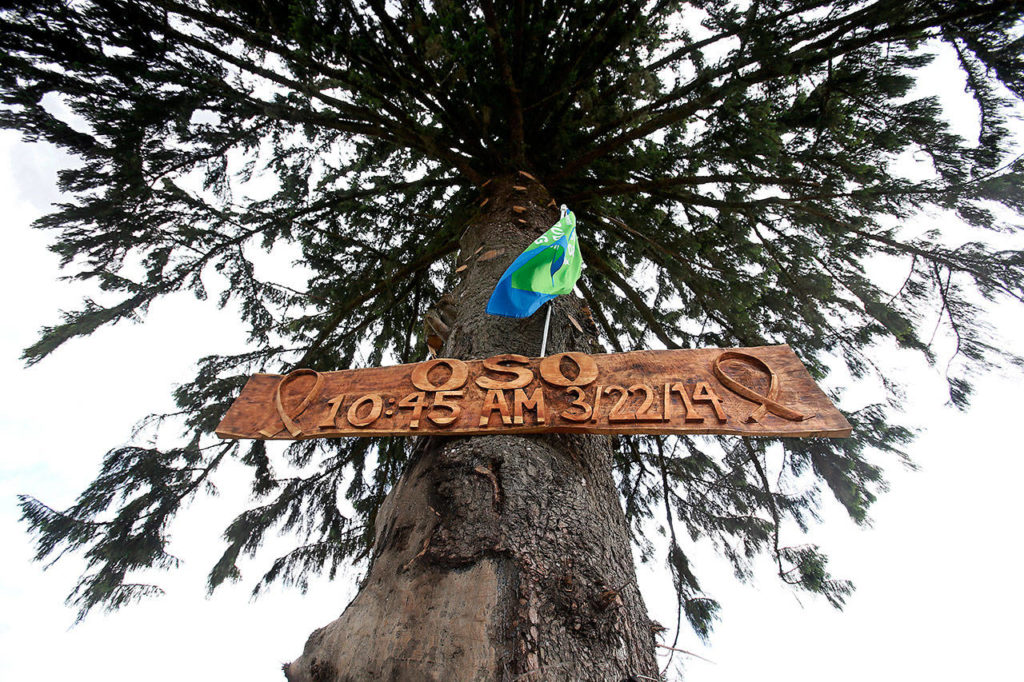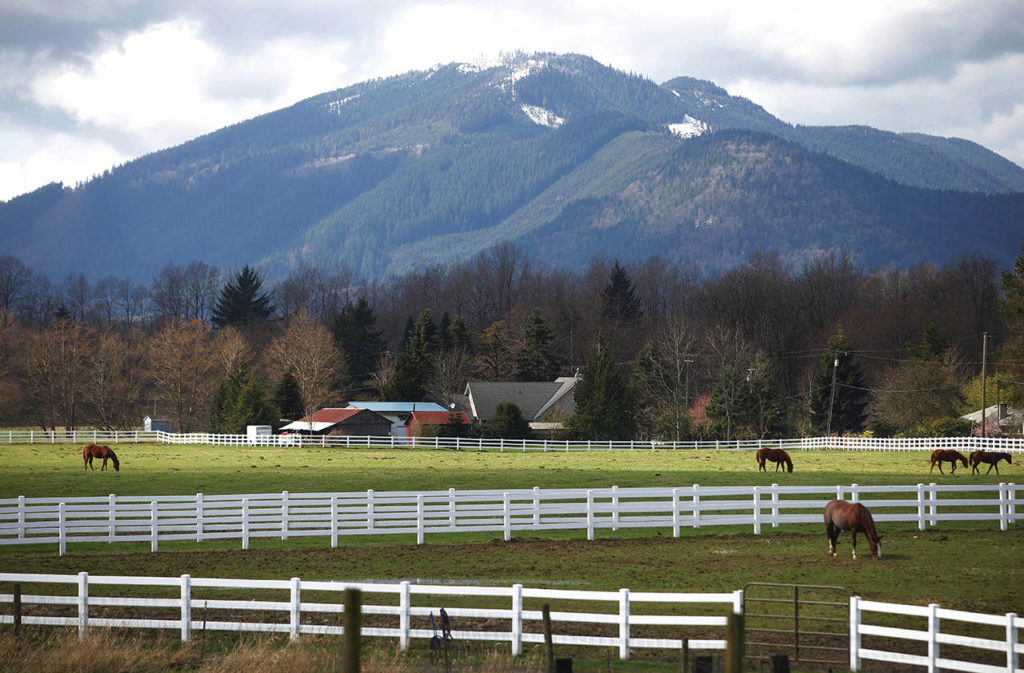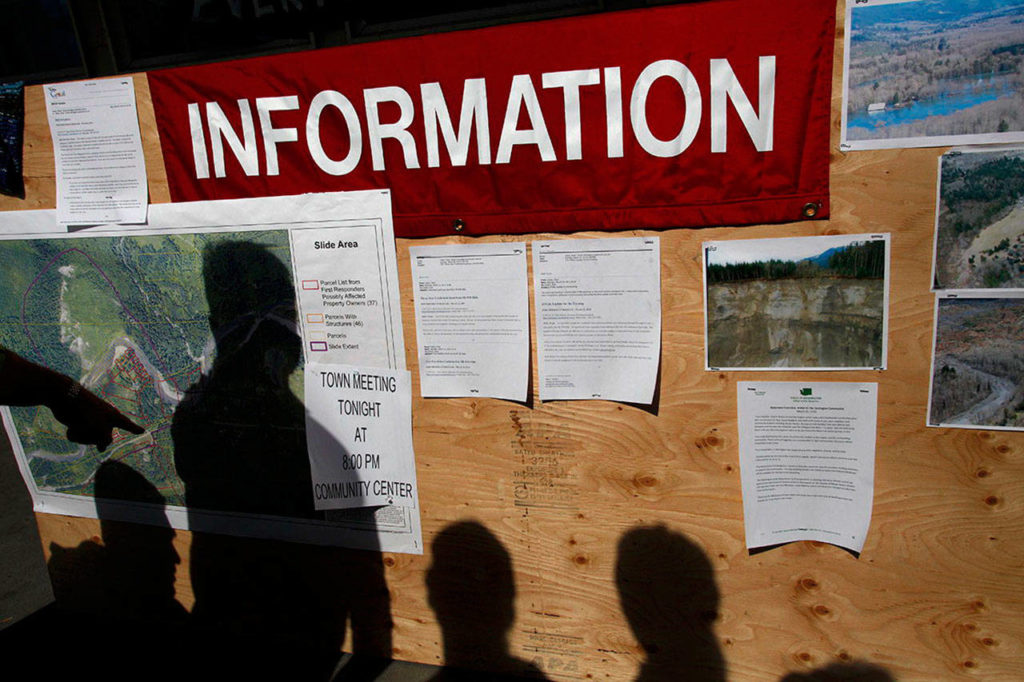Editor’s note: “The Rising” was published on May 30, 2014, just 69 days after a devastating mudslide near Oso, Washington, wiped out a rural neighborhood and killed 43 people. This is the original text and reflects the information that was available at the time.
• • •
Cascade Valley Hospital: A place for waiting
They couldn’t stay home.
They didn’t know where to go.
So they went to the hospital.
Hospitals have answers, right? A doctor’s confidence. A nurse’s compassion.
People filled the waiting room at Cascade Valley on March 22.
Their eyes reflected the fear, the chaos, the unknown.
Staff shared coffee. Warm cookies. Phone chargers. Hugs.
Five patients came in, covered in mud. Bones were broken, skin punctured, spouses and children missing.
Nurse Barbara Hinshaw ran the emergency room. She was checking with other hospitals, asking after her patients’ loved ones: hair color, eye color. But the mud was indiscriminate. It coated everything, even people, in that same brownish-gray.
Hospital staff waited and hoped for more patients.
More patients meant more survivors.
The hours passed.
Even seasoned professionals turned to their parents that night for comfort. Sharing what they heard, what they saw.
Hospital workers found family, schoolmates, neighbors among the lists of the missing and the dead.
Arlington’s not so big.
Surgeon Paul Naumann stayed until the sun went down, and the emergency radio went quiet.
Hope had already begun to fade.
— Rikki King
• • •
Rhodes River Ranch: A place for communion
Drawn by the beauty and the rich soil of the mountain foothills, homesteaders tamed the lush green land off Oso Loop Road more than a century ago. Dairies followed. These days, there’s a ranch for 100 world-class show horses.
A restaurant, too, known for its flat iron steak and pea soup.
Yet it’s more than that. Much more.
Rhodes River Ranch is the trusted neighbor behind the white post-and-rail fence, the friend who invites local kids over at Christmas each year.
After the mudslide, people around Oso gathered at the ranch to share stories and mourn at victims’ memorials, to raise money for survivors at benefit concerts and a bachelor auction.
It became a call center for family and friends, and gave space for National Guardsmen to privately process the horrors of the mud.
The ranch let folks be close to home, even when their homes were gone or far away. That’s what neighbors do.
Night after night, its restaurant stayed open late, letting those who needed to talk decide when it was closing time. The coffee was always hot.
And when the lights shone bright inside the riding arena, pastors’ words celebrated lives lost to the hill they called home.
It was time to say goodbye. And from up in the rafters, all around, a flock of sparrows sang.
— Eric Stevick
• • •
Oso Community Chapel: A place to pause
Flowers, like funerals, mark beginnings and endings.
Celebration and sorrow.
The five-foot chicken-wire cross held daisies and tulips. People could kneel there. They could cry. They could pray.
They could lay carnations and roses at its foot.
It was somewhere to go, to do something, anything.
Tina Ray, the pastor’s wife, pulled the cross from storage. She set it up on the lawn of Oso Community Chapel, facing Highway 530. The church has stood more than 100 years.
People were drawn there. They could pause to weave a flower into the wire cross and become part of it all.
— Rikki King
• • •
Darrington Community Center: A place to rely on
The teen wrapped her slender arms around a barrel-chested man with a shock of white hair.
She moved across the hardwood floor, saw the mayor, then hugged him, too. He whispered in her ear and she tightened her embrace.
Two days later, the girl’s sister was found. Another life lost.
The Darrington Community Center was built 60 years ago with donated labor and materials — pitching in is a town tradition. The center remains a testament to the logging town’s self-reliance.
It’s where everyone comes together for basketball games, wedding showers, funerals; a place of friendship and caring.
It’s where everyone gathered after the disaster. People felt safe there. Anyone could get a warm meal or take a hot shower. They could go there to cry, share, remember.
And to vent at community meetings, to pepper outsiders running the disaster response with tough questions and then offer a strong handshake afterward.
In the kitchen, folks from town cooked for all: families who had lost their homes, their loved ones who’d showed up in town, and anyone else helping in any way they could.
Quietly, through notes on bulletin boards, people opened up their homes to whoever needed a place to sleep.
The Darrington way.
— Eric Stevick and Rikki King
• • •
Darrington IGA: A place for news
The bulletin board outside the Darrington IGA is one place people shared news of the mudslide and words of comfort.
On April 28, the day active search operations were suspended, the board was dominated by a large mural of brightly colored flowers made by students at Nautilus K-8 school in Federal Way.
“I hope this makes you smile,” read one message, written on a drawing of a blue tulip.
Nearby was a large, hand-lettered sign with Scripture: “ ‘Though the mountains be shaken and the hills be removed, yet my unfaltering love for you will not be shaken, nor my covenant of peace be removed,’ says the Lord who has compassion on you. — Isaiah 54:10”
— Scott North
• • •
The spruce: A place of strength
The Sitka spruce stood firm as the mudslide scoured away its bark and so much more from this quiet valley.
Trees. Homes. People.
Gone.
Not the old spruce. Its branches still rose to the cold gray sky as rain and tears fell.
Trees like these only grow in river valleys soggy with rain and mist. It’s at least three stories tall with a trunk six feet across. How long it has been here, no one can say.
The Oso tree was one of the few landmarks for those who call this valley home as they waded into the mud. It greeted those who came to help them look for the lost.
It was there as the ground surrendered photos and furniture, blenders and Bibles — the comforts of homes ripped apart by earth that suddenly rolled across the valley 140 centuries after it last saw sun.
The spruce was there when searchers removed their hard hats and turned off their heavy equipment, the silence marking another person found. One of the dead was an angler who had longed for a home where he always heard a river’s song. He was found almost under its limbs.
In a landscape stripped of the familiar, the big scarred tree remains.
Searchers found a large cedar plank in the mud. They took it to a local mill. Planed and shaped, the fragrant slab was hung on the spruce’s trunk. A carved inscription memorializes the morning the hill fell: “Oso. 10:45 a.m. 3/22/14.”
Workers lined up their excavators, like cavalry on a parade ground. They laid a wreath at the spruce’s trunk, carried by two people from this place who spent a month in the mud, searching.
They stood firm.
The roots are strong.
— Scott North
Talk to us
> Give us your news tips.
> Send us a letter to the editor.
> More Herald contact information.






























